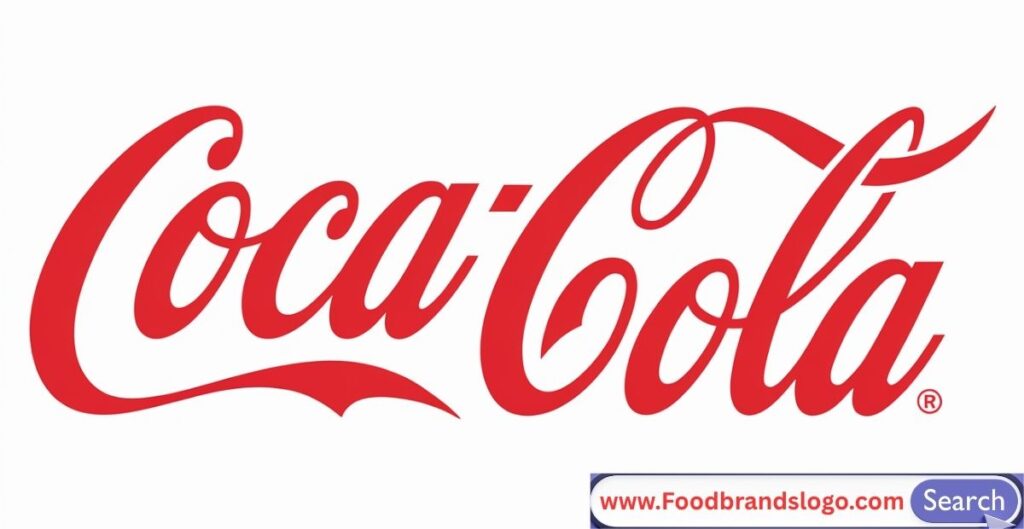The Coca-Cola script is one of the few logos in the world that instantly evokes nostalgia and recognition. Coca-Cola’s flowing letters span decades, cultures, and boundaries, appearing on everything from enormous billboards in Times Square to little cafés in isolated towns. However, have you ever pondered how those rounded red letters rose to the top of the global fame rankings?
This article delves deeply into the Coca-Cola logo, examining its meaning, evolution, hidden stories, interesting facts, and design secrets that make it iconic, whether you’re a history buff, design enthusiast, or just an inquisitive reader.
The Meaning Behind the Coca-Cola Logo

The drink’s two original main ingredients, kola nuts and coca leaves, are referenced in the Coca-Cola name itself. However, the logo? It represents joy, kinship, and heritage and is much more than just a title.
White stands for innocence, youth, and simplicity, whereas red conjures up feelings of vigor, passion, love, and excitement. When combined, they produce a brand image that is energizing and upbeat. It’s interesting to note that some people think the red color gained even more cultural weight because Santa Claus’s present red costume was made popular by Coca-Cola’s winter ads. This is a contentious but unquestionably iconic truth.
The Spencerian script itself is a sophisticated and cozy script that conveys warmth and accessibility. It emphasizes tradition and dependability and has remained mostly unaltered for more than a century.
A Brief History of the Coca-Cola Brand
Dr. John S. Pemberton, a pharmacist from Atlanta, created Coca-Cola in 1886 and first sold it as a medicinal tonic to treat nervousness and headaches. His recipe included sugar, kola nuts, coca leaves, and other unidentified components.
Pemberton sold the formula to Asa Candler, a shrewd businessman who made Coca-Cola a popular soft drink, after his sales failed to take off. Coca-Cola’s popularity in America and abroad skyrocketed thanks to Candler’s aggressive advertising campaigns. Coca-Cola became a global craze by the time of World War I, when soldiers started asking for it abroad.
The Evolution of the Coca-Cola Logo (with Visual Descriptions)
Let’s walk through how the logo has evolved over the years:
1886 – Simple Wordmark

The very first logo was basic: all-uppercase serif text, in black and white. It appeared for the first time on May 29, 1886, in an Atlanta newspaper ad. Plain, functional, and unremarkable — but it was a start.
1887–1890 – The Birth of Spencerian Script

Bookkeeper Frank M. Robinson suggested the name “Coca-Cola” and hand-designed the now-famous script using Spencerian penmanship, popular at the time. This version introduced the elegant, looping letters that defined the brand — a massive step forward in identity.
1889–1892 – Elegant Refinement

The script became more stylish and elaborate, with longer, curved C’s and refined strokes. Rhomboid diamonds were subtly added inside the C’s, and a bold comma appeared at the end of the words. Negative space separated “Coca” and “Cola” cleanly.
1890–1891 – Decorative Swirls

In a bold but brief experiment, Coca-Cola adopted an ornate and highly decorative version, with exaggerated flourishes and elongated C’s that looked like musical notes. It was short-lived — used for just a year due to its complexity.
1891–1899 – The First Red Logo

This marked the first colorful version. The script was encased in a rectangular red box, setting it apart visually. The vibrant red background became an enduring hallmark from this point on.
1900–1941 – Return to Simplicity

The logo reverted to the cleaner Spencerian script — bold, balanced, and clear. From 1903, the phrase “Trademark Registered” appeared in the tail of the first C, marking legal protection.
By 1934, Coca-Cola’s signature bright red color took center stage in advertising, strengthening its identity.
1941–1987 – Bold and Streamlined

The script was slightly italicized and enlarged. The rectangular box was removed, letting the lettering stand alone. The logo gained stronger, cleaner lines, adapting to modern print and packaging.
1958–1960 – Fishtail Logo

The script was placed inside a bright red arching shape, nicknamed the “fishtail.” Playful and modern for the era, it graced soda fountains and marketing materials.
1969 – The Red Disc and Dynamic Ribbon

Coca-Cola introduced the now-famous red disc and the Dynamic Ribbon Device — the curving white wave beneath the script. This symbolized energy and fluidity and has remained central to brand imagery ever since.
1987–2003 – Sharper, Digital-Ready

With digital media rising, the logo was refined to be sharper, bolder, and more legible across formats. The Dynamic Ribbon became sleeker.
2003–2007 – Coca-Cola Classic & Depth
Following the “New Coke” controversy of the 1980s, Coca-Cola emphasized “Coca-Cola Classic”, bringing nostalgia into branding. Shadowed, embossed effects gave the logo dimension.
2007–2021 – Back to Basics

Coca-Cola stripped the extras, returning to flat red and white, with the Dynamic Ribbon intact. Clean, modern, and globally consistent.
2021–Present – The Hug Logo & “Real Magic”

Coca-Cola introduced the “Hug” logo, where the letters curve slightly as if holding an invisible bottle — symbolizing connection and sharing. It launched alongside the new brand platform “Real Magic”, emphasizing togetherness in a divided world.
Design Elements & Symbolism
- Colors:
Red = Passion, excitement, energy
White = Purity, simplicity, youthfulness - Font:
Spencerian script = Tradition, elegance, friendliness - Shapes:
The Dynamic Ribbon adds flow and dynamism, while the red disc anchors global recognition.
Hidden Messages?
Coca-Cola claims that the logo solely conveys aesthetic appeal and brand heritage, with no deliberate hidden messages.
Some enthusiasts, however, have conjectured amusing “finds,” such as the Danish flag’s likeness in the “o-l” portion, a peculiarity Coca-Cola used in a Danish advertising campaign.
Fun Facts about Coca-Cola and its Logo
- Only two senior employees are aware of the Coca-Cola recipe, and they never go on trips together.
- North Korea and Cuba do not formally sell Coca-Cola.
- A cocoa pod served as the inspiration for the first glass Coca-Cola bottle (1915), which eventually evolved into the recognizable contour bottle.
- More than any other brand, Coca-Cola has sponsored the Olympics since 1928.
- It became simpler to enjoy Coke on the go when plastic coolers replaced metal ones.
Coca-Cola Slogans Through History
Coca-Cola’s slogans have evolved just like its logo. Some memorable ones include:
- “The Pause That Refreshes” (1929)
- “It’s the Real Thing” (1971)
- “Open Happiness” (2009)
- “Taste the Feeling” (2016)
- “Real Magic” (2021 – present)
Conclusion: Which Logo Do You Love Most?
For more than 130 years, the Coca-Cola logo has subtly changed throughout time to become more than just a brand mark. From its elaborate swirls to its modern, bold writing, every iteration captures the spirit of its era as well as the timeless values of Coca-Cola: joy, connection, and refreshment.
It’s your turn now to think about which Coca-Cola logo you like best and why.
Do you find the early Spencerian script’s old charm appealing? The fun fishtail of the 1950s? Or the chic, contemporary embrace logo?
Talk about it, and while you’re doing it, have a cold Coke.
FAQs
What does the Coca-Cola logo represent?
With consumers all around the world, the Coca-Cola logo embodies the brand’s identity and fosters favorable connections. Its two original primary constituents, cola (nuts) and coca (leaf), are the source of the name. White stands for innocence, youth, and nobility, while the classic red color denotes power, passion, love, and vitality. The logo has evolved into a worldwide representation of joy and relaxation.
Who designed the original Coca-Cola logo?
In 1887, Frank M. Robinson created the iconic Coca-Cola logo. It’s interesting to note that Robinson wasn’t a professional designer but rather a bookkeeper. The Spencerian script, the predominant handwriting style of the day, was the penmanship style he used to develop the unique script. His creation served as the basis for one of the most iconic logos in the world.
Why is the Coca-Cola logo red?
Although it first appeared in red in 1891, the Coca-Cola logo didn’t fully embrace its distinctive red color until 1934. The color red was selected to represent power, fervor, and vitality. According to some studies, Santa Claus’ red suit may have served as the company’s inspiration, fostering favorable connotations with happiness and festivity. Additionally, the red and white combo conveys purity, optimism, and youth.
How has the Coca-Cola logo evolved over time?
Since 1886, the Coca-Cola logo has changed a lot. It began as a straightforward serif-letter wordmark in all caps, black and white. In order to attain the ideal balance, the logo underwent numerous revisions, including the addition of red coloring in 1891, the addition of ornate swirls in 1890, and ongoing improvements. In 2021, the “hug logo”—a sign of sharing and connection—was the most current modification.
What font style is used in the Coca-Cola logo?
The unique font used in the Coca-Cola logo is modeled from the popular late 19th-century handwriting style known as Spencerian script. This swirling, cursive style strengthens the brand’s visual identity and adds elegance to the emblem. Even if the typeface has been improved throughout time, it still has the elegant, flowing look that makes it instantly recognized.
What was the first Coca-Cola logo like?
Compared to the current logo, the original Coca-Cola logo from 1886–1887 was incredibly simple. It was a simple black-and-white wordmark with three all-caps characters in a serif font. On May 29, 1886, the Atlanta Journal published the first advertisement for this original logo. The intricate writing that would later become iconic stands in stark contrast to the original design’s simplicity.
Are there any hidden messages in the Coca-Cola logo?
The official information is that the Coca-Cola logo does not include any purposeful hidden messages. The brand’s history, ideals, and awareness of its iconic status are all conveyed through the design. The company’s main goal has always been to establish a visually appealing and distinctive brand emblem, despite the fact that there are many different interpretations and theories regarding hidden meanings.
What is the “hug logo” introduced in 2021?
When the Coca-Cola logo was updated in 2021, it became known as the “hug logo.” Classic curved letters are positioned in this design as though they were clutching an invisible bottle, signifying friendship and the sharing of a Coca-Cola with pals. Coca-Cola’s new “Real Magic” brand campaign was accompanied with this logo, which symbolizes the company’s emphasis on uniting people by common experiences.
What formats is the Coca-Cola logo available in?
For various uses, the Coca-Cola logo is accessible in a variety of digital formats. Typically, businesses employ SVG, JPG/JPEG, and PNG file formats. JPG/JPEG is used for regular photography and print applications, SVG is used for scalable vector graphics that retain quality at any scale, and PNG is used for web use with transparent backgrounds.
How did the Coca-Cola logo contribute to the brand’s success?
The Coca-Cola logo’s ability to instantly recognize and emotionally connect with people has been crucial to the brand’s success on a worldwide scale. Coca-Cola is one of the most well-known brands in the world thanks to its striking red and white color scheme and constant use of the distinctive typography. The company’s flexibility while preserving its essential character is reflected in the logo’s development, which has greatly aided Coca-Cola’s rise to prominence as a major international beverage brand.

